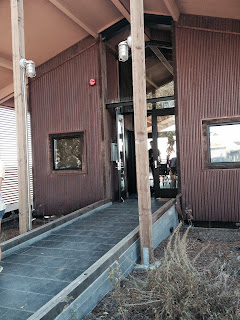 |
| Old ranch building now renovated |
In 2005 the Sonoma Land Trust obtained Sears Point, which is 2,327 acres. The site was originally an old ranch building which was renovated and completed in 2011. It was constructed by an architect from San Francisco for free, and made of reclaimed barn wood.It was supposed to be the location of our newest entertainment the Graton Casino! However the land was previously a tidal marsh and it was determined to be an unfit location by consultants and the Native American tribe.
Currently, Julian is working on the Sear's Point wetland and watershed restoration project, where he is trying to obtain 1000 acres to return to the tidal marsh. He will also be working closely with the agricultural workers and establish good relationships with them. The area is dominated with Italian vine grass, and they hope the farmers will help to desiccate the grass.
 |
Julian Meisler and classmate Vita holding a map of the Baylands |
 |
This photo is showing the storm water pump to help keep the water clear. The pumps are quite expensive running approximately $700,000 and they can pump 11,000 gallons per minute.
Other key components of the Sears Point wetland and watershed restoration project is to bring back species and open up the Baylands as a trail for public use. Julian talked to us about recreating habitat for the California red legged frog, as there are already some present in the watershed. He hopes to eventually establish breeding grounds and colonize the area for them.
 |
| California red legged frog. We hope to see more in the Baylands! |
 |
| Classmate Amanda holding Pickleweed! |
We end our blog with some miscellaneous pictures from the field trip, such as the salt marshes some of the grass fields, etc!
 |




No comments:
Post a Comment